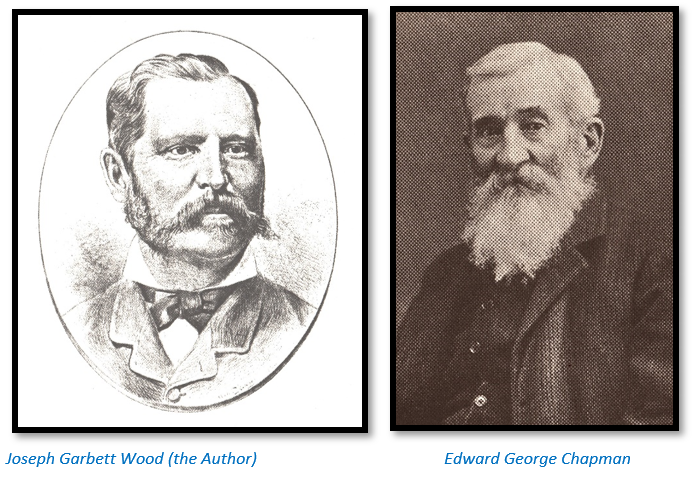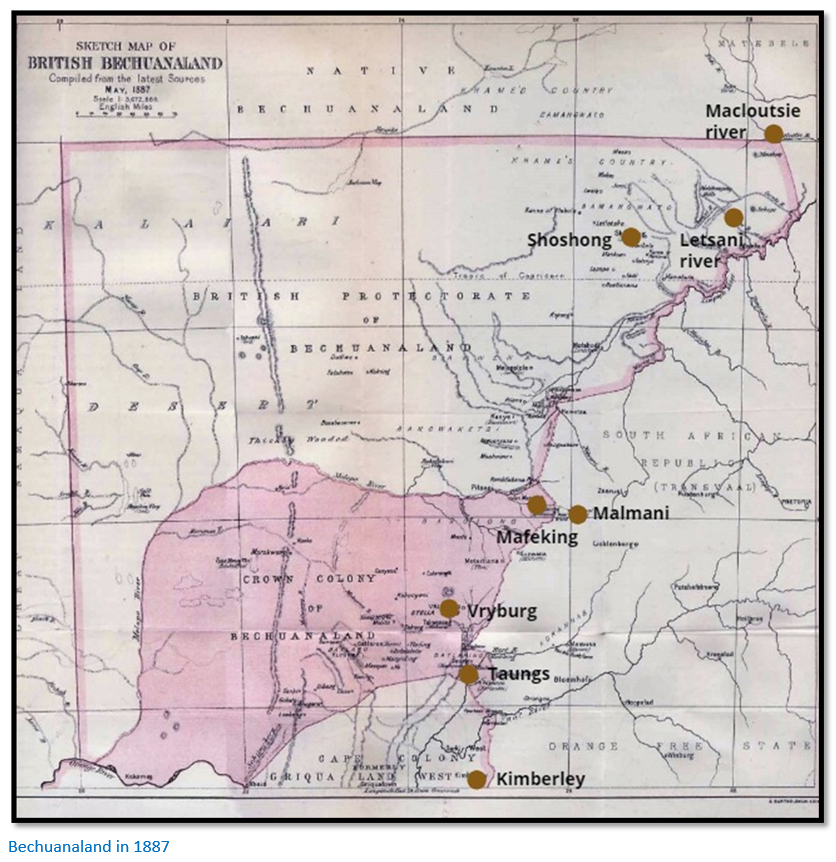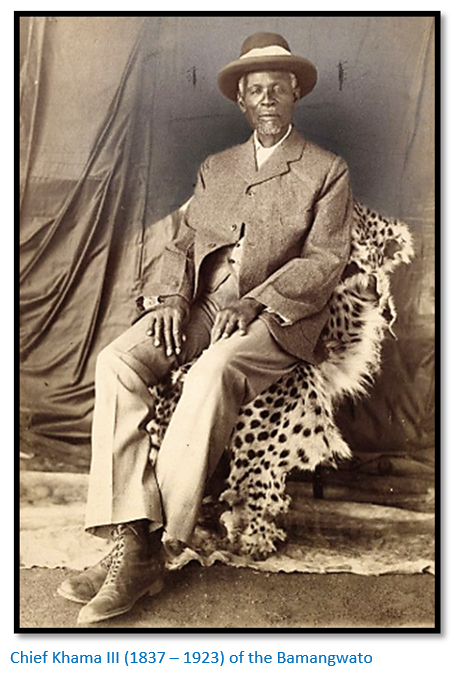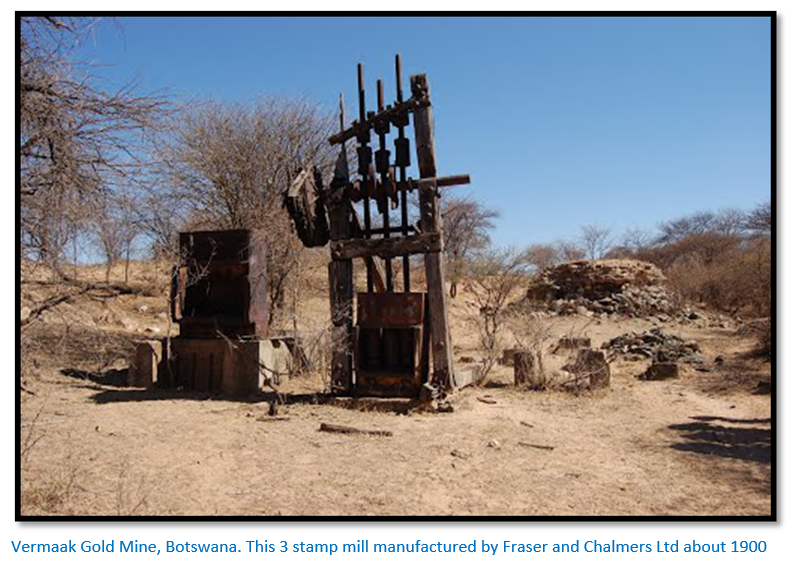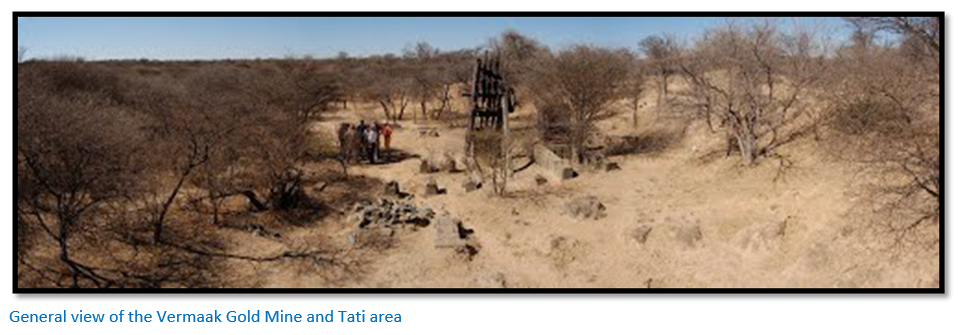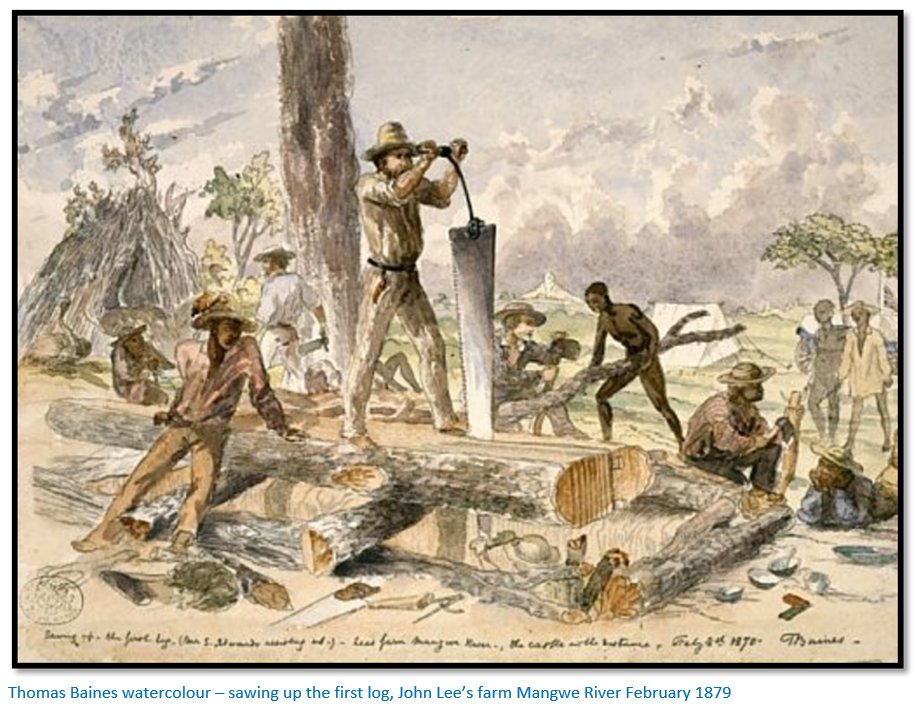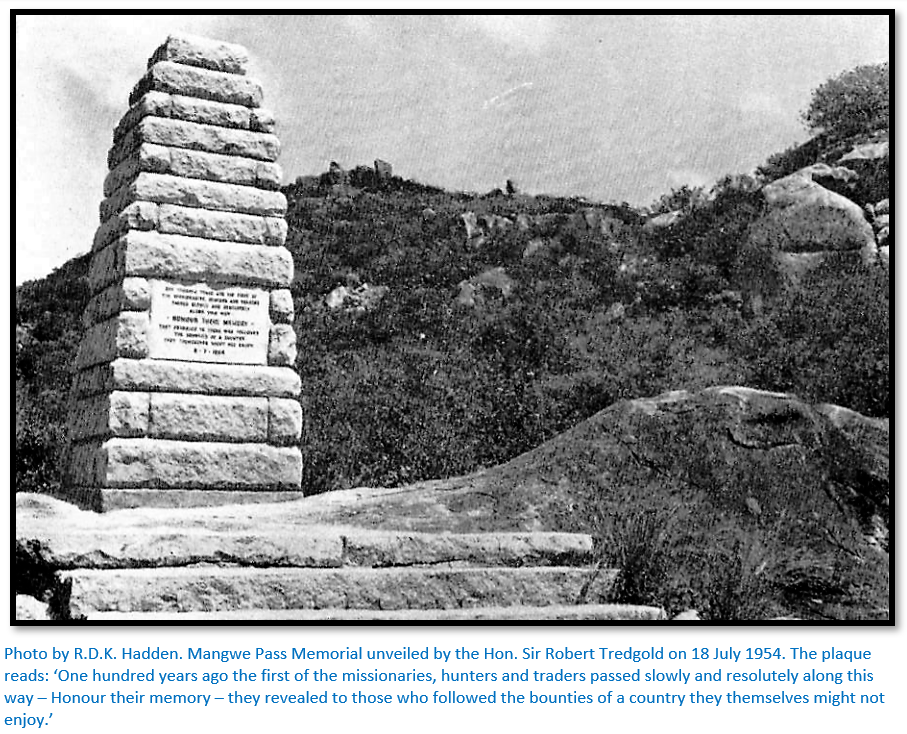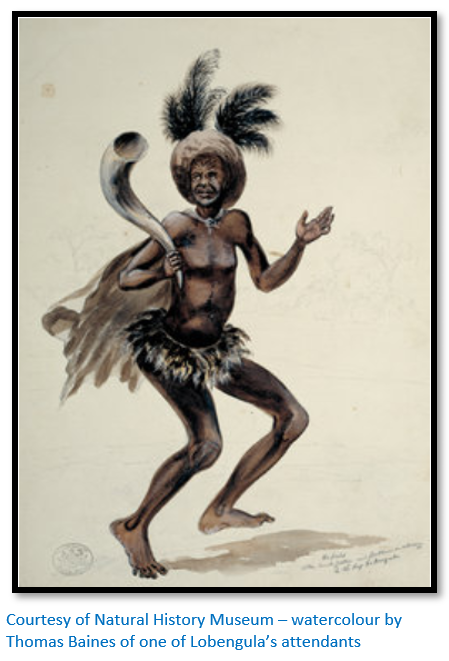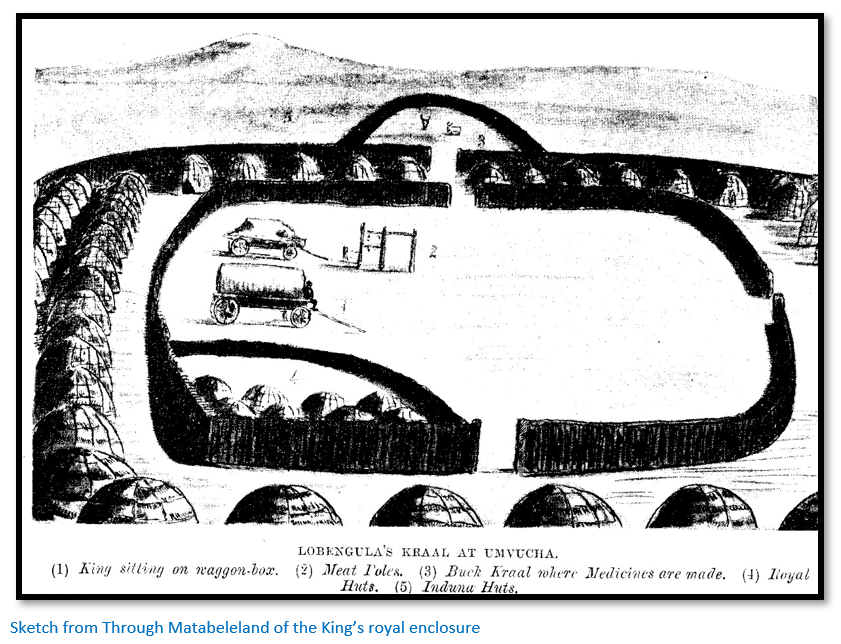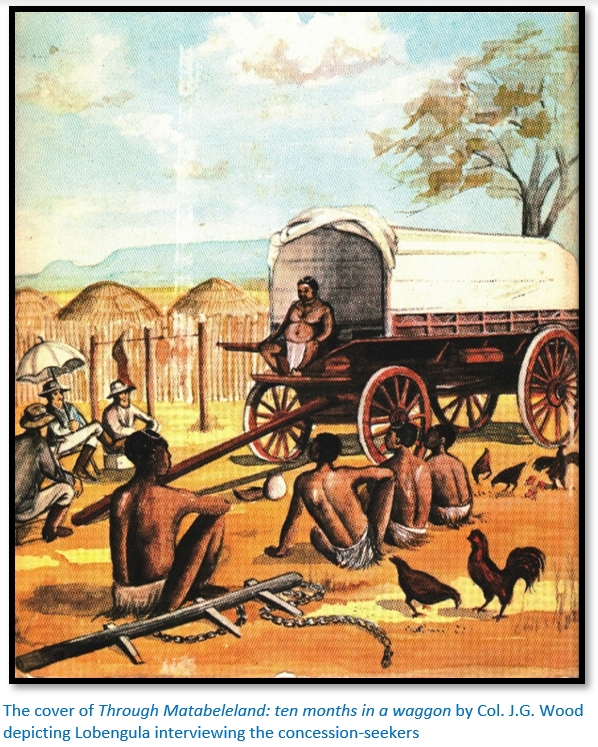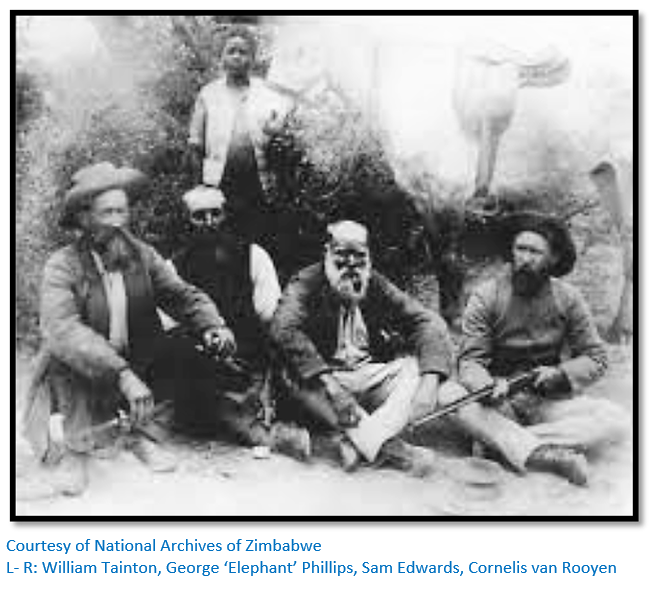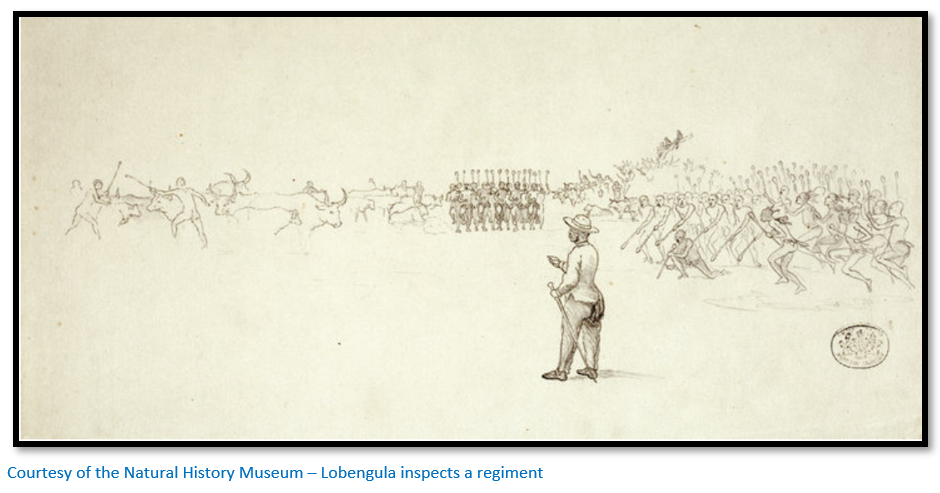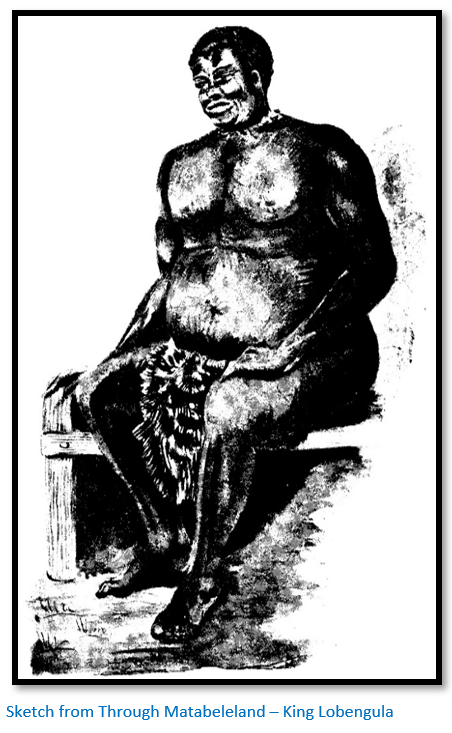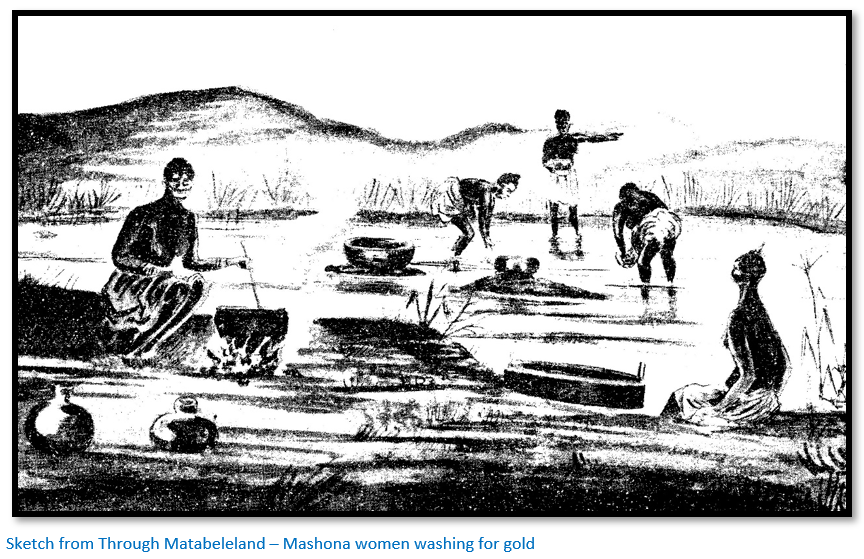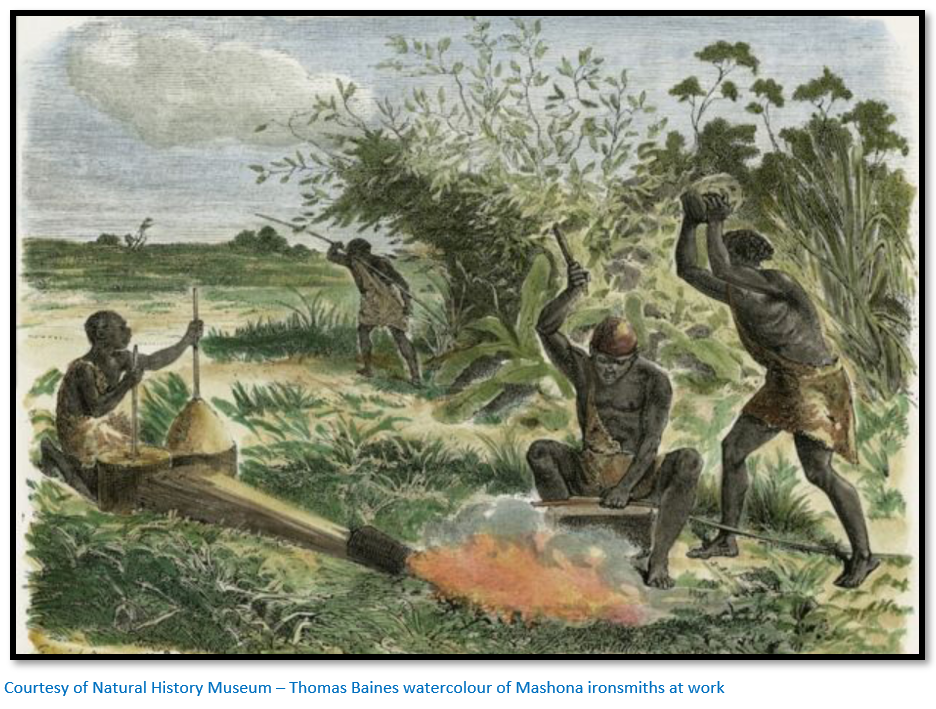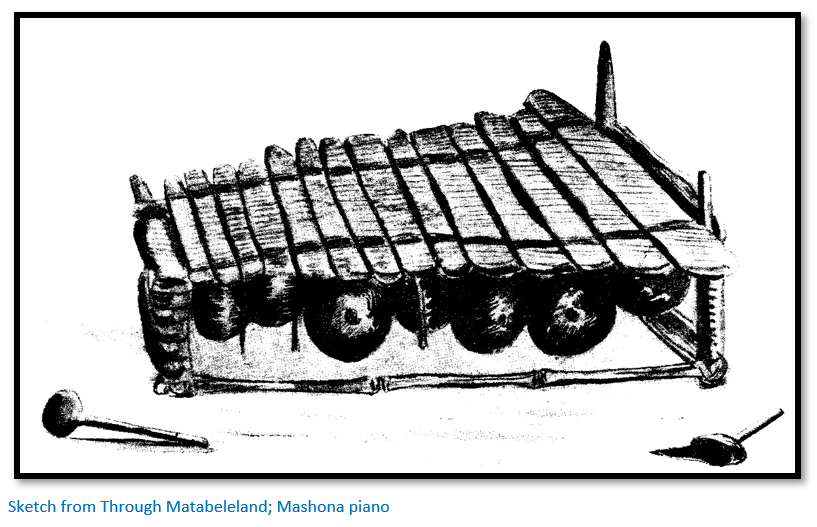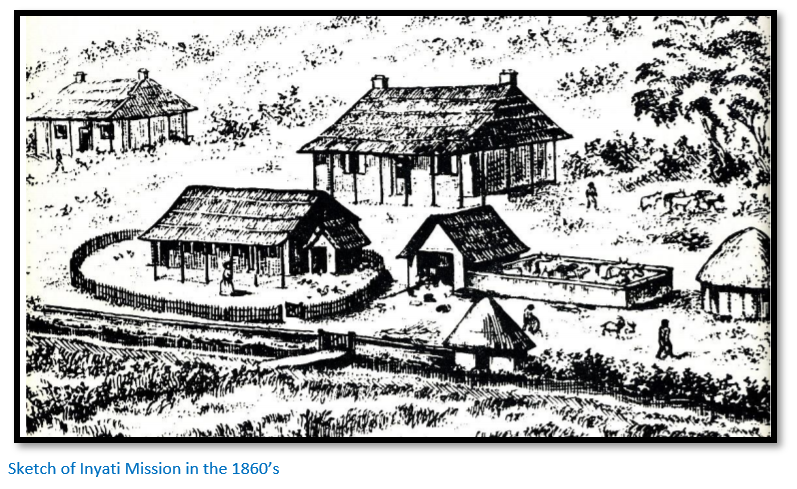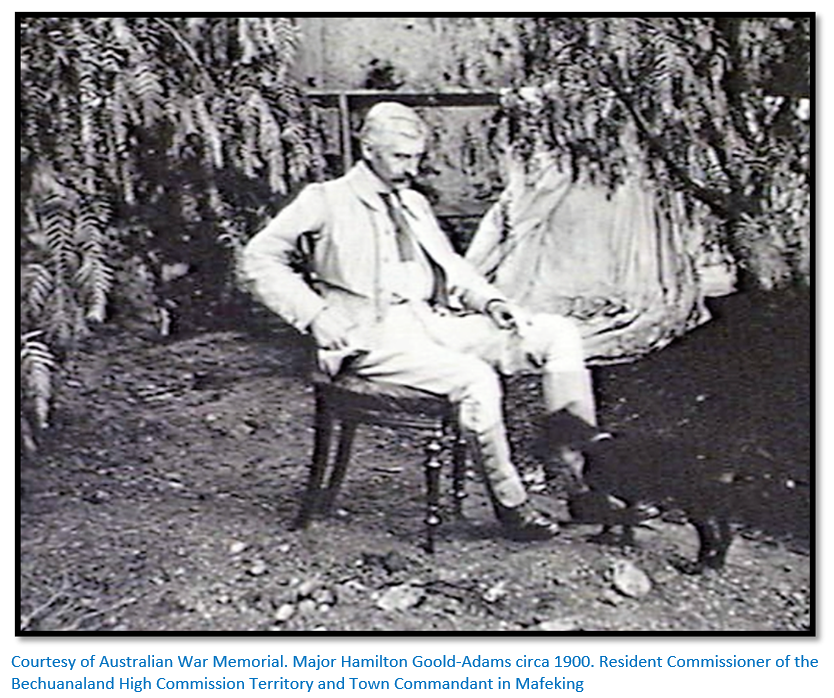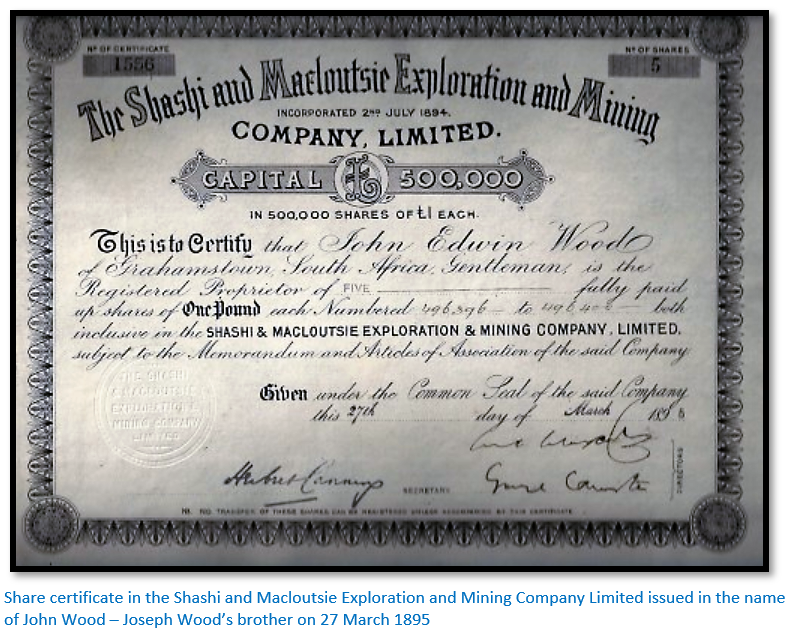The Wood-Chapman-Francis syndicate of concession seekers
The Wood-Chapman-Francis syndicate appealed to Lobengula, King of the amaNdebele for a mineral syndicate in Mashonaland. Although they were given permission to visit Mashonaland and saw plenty of evidence of gold being present they did not get a concession there. Lobengula did award them a concession on 17 November 1888 within “the disputed territory” between the Shashe and Macloutsie, now Motloutse rivers, but the area was also claimed by Khama III of the Bamangwato. The amaNdebele hunted the area and Khama’s people grazed their cattle and although hostile to each other, the tribes did not resort to open warfare.
The Rudd Concession had been signed by Lobengula just two weeks earlier on 30 October which provided the motive for Rhodes, supported by local officials of the colonial office, to harass and effectively deprive the syndicate of their concession and they never carried out any mining activities.
Members of the Syndicate
The syndicate formed in Grahamstown in March 1887 where all its members were resident:
Joseph Garbett WOOD was born in Grahamstown on 14 February 1833, the son of an 1820 settler, George Alfred Wood and Susannah née Garbett. He died 25 September 1892 aged 59 years and had two sons and eight daughters with his wife Lydia née Cock (10 November 1831 – 1924)
Edward George CHAPMAN was adopted as an orphan and brought up by John William Chapman, also descended from 1820 settlers, a resident trader at Kuruman. Chapman made several treks into Matabeleland in the 1860’s where he met Mzilikazi and knew many of the early hunters, traders and missionaries. He traded at Kuruman and led the Port Elizabeth party to Tati in 1868 and was at Shoshong in July 1879, when he promised to forward letters for the first Jesuit missionaries by the "traders' post" before taking up residence at Grahamstown from 1880. In 1884 John Mackenzie requested that Chapman be his deputy commissioner at Shoshong in Bechuanaland, but Mackenzie’s request was turned down by the colonial office.
William Curle FRANCIS travelled from Grahamstown in 1864 with Chapman into the interior and by
1870 was living in Shoshong from where he made trading trips into Matabeleland. He travelled with his wife and George and Cornelia Westbeech to the Victoria Falls and the upper Zambesi in 1875. In 1872 he and Richard Clarke started the firm of Francis and Clarke in Shoshong and Grahamstown and traded for fifteen years in ivory, ostrich feathers and karosses until they were expelled in 1887 by Khama III for trading in liquor.
Prior concessions in the Tati area
Before the discovery of gold the Tati area was just part of the territory that travellers, missionaries and hunters passed through on their way to the interior. They included Robert Moffat, Sam Edwards, Thomas Morgan Thomas, William Finaughty, Henry Hartley and Karl Mauch. It was Mauch’s 1867 announcement of the discovery of gold that sparked the first gold rush into the area.
Various individuals and groups of prospectors, including an Australian party arrived in 1869 and a small village sprung up on the Tati river’s northern bank, but there was no mining machinery until the London and Limpopo Company under Sir John Swinburne imported a three-stamp mill and wood-burning steam engine. The Glasgow and Limpopo Mining Company also established itself at Tati.
However, the diggings provided insufficient ore to make the mining profitable and many of the once bustling community of 250 Europeans left for the diamond fields at Kimberley with the numbers dwindling to a handful of Europeans, besides the Piet Jacobs family who carried out hunting. By 1879 George Phillips ran the last of the London and Limpopo Company properties.
In September 1880 Sam Edwards obtained from Lobengula a concession over the disputed territory between the Shashe and Ramaquabane rivers which had lapsed from the London and Limpopo Company for an annual payment of £30. A new syndicate Northern Light Gold Mining Company with Edwards as its manager and the syndicate members of William Francis, Daniel Francis (after whom Francistown is named) Hugh Dobbie and Samuel Dobbs as first directors took over.
In 1888 the original shareholders sold their rights to the Tati Concession Mining and Exploration Company Limited belonging to Alfred Beit and Baron d’Erlanger with Sam Edwards remaining the manager. The Rudd Concession signed on 30 October 1888 excluded the Tati area.
Journey from Grahamstown in 1887 to Mafeking, now Mahikeng
Wood and Chapman left Grahamstown on 23 March 1887 and trekked through Kimberley, Vryburg, Mafeking (now Mahikeng) and Molepolole and met Francis at Shoshong.
“We obtained a span of fairly good trek oxen at £5 10s each and left Diamondopolis [Kimberley] on 29 March. Barkley West, on the Vaal River….where hundreds once washed for diamonds at Pniel, we only saw one solitary native at work. Here we had to wire for permission, which was granted, to pass through Bechuanaland with arms and ammunition…at Taungs it is a curious fact that we found provisions and supplies cheaper here than at Grahamstown, in consequence of the drawback on customs duty granted to Bechuanaland.”
“We enter Vryburg, the chief town and seat of government of Bechuanaland. There are a few good stone buildings here and it is noticeable that many of the storekeepers belong to that pushing race which is now determined to get as large a slice of Africa as possible – the Germans.”
“Our party went from this place [Mafeking] to Malmani and was by no means favourably impressed with the gold reefs. At this time there were so many prospectors at work that the only available bed for a stranger was the billiard table and long weary waiting was necessary before it could be obtained.”
“The Administrator [Sidney Shippard] and Colonel Martin [Bechuanaland Border Police] were at Mafeking at this time. The former gave us a useful introductory letter to Lobengula and we greatly admired the efficiency of the police under the command of the latter officer.”
Mafeking, now Mahikeng to the Tati goldfields
At Chief Gasitsine’s town: “having seen some promising quartz reefs in the territory, we applied for a concession, but found that some Mafeking people had been before us.”
They arrive at Sechele’s town, Molepolole: “With the exception of Mafeking, where there is a Wesleyan missionary, all the other tribes have ministers under the London Missionary Society.”
The road to Shoshong was sandy and hard going for the trek oxen: “Abundance of game surrounded us on our trek. These comprised, among others, wildebeest (brindled gnu) koodoo and guinea-fowl, but the pasturage on the borders of the Kalahari is poor and the country seems only fit for Bushmen and snakes…The women gather the wild melons which grow plentifully in the sand and form substitutes for water. The men carry bows and poisoned arrows, while the women and children have pointed sticks, which are principally used for digging up roots.”
Outside Shoshong the chief’s son met them on a horse and fashionably dressed with watch and chain and top-boots and soon afterwards Chief Khama III arrived and welcomed the party. The town was originally chosen for its defensive position against the amaNdebele. The Scottish missionary John Mackenzie lived at Shoshong between 1862 – 76 and canvased colonial office support for the establishment of what became the Bechuanaland Protectorate to protect the Bamangwato and other local people against Boer infiltration. At the time Shoshong was an important stop on the trade routes north and south and familiar to most early explorers. A water shortage forced the town to move 95 kilometres north-east to Old Palapye in 1888 – 9.
At Shoshong they met Francis who managed a trading store and had a cattle post near the junction of the Limpopo and Little Notwani rivers to which the whites of Shoshong retreated whenever there were rumours of an impending amaNdebele raid.
On 5 May: “a fine frosty morning, which is hailed as a sign that horse-sickness will stop” they trekked on through fine-looking country which thirty years before had been infested by tsetse fly which had now gone. Wood notes that after cattle and horses have been stung by tsetse fly they show no outward symptoms until the first rains fall, when they waste away and soon die.
The Letsani river was dry, but guinea-fowl and game were plentiful and at Selous’ former outspan they found numerous bones and animal skulls from his hunting activities. In those times lions were plentiful and at night the wagons and oxen would be protected by barricades of thorn bushes. Here they encountered their first baobab (Adansonia digitata) trees.
On 18 May they arrived at the Macloutsie river which was dry and considered by the amaNdebele to be their border. At latitude 22° South it was also considered the northern border of the British Protectorate of Bechuanaland. Later in the day at the Shashe river they met John Fry taking gold and quartz specimens on behalf of Sam Edwards from the Tati goldfield down to Kimberley.
The Tati concession had originally been granted by Lobengula to Sir John Swinburne of the London and Limpopo Mining Company in 1870, but the concession lapsed when the annual £30 payment was not made. In 1880 the concession was acquired by the Northern Light Mining Company, a syndicate formed by Danial Francis, Sam Edwards and others and later renamed the Tati Concessions Limited.
The Wood-Chapman-Francis syndicate had seen some likely looking quartz reefs on their journey and wrote to Khama for permission to prospect on their return journey, but to their disappointment received a letter from him turning down their proposal…the first of a number of frustrations for the syndicate.
Tati was reached on 22 May where they met “Far Interior” Sam Edwards and examined the shafts of the Blue Jacket, New Zealand and Police reefs and the crushing equipment made up of an antiquated three-stamp mill imported originally by Sir John Swinburne and powered by a Clayton 12 horsepower wood-fuelled steam engine. Their last seven tons of crushed quartz had yielded 33 ounces (1,026 grams) of gold. Water was pumped from the Tati river; native Zambesi labour was paid in beads which cost seven shillings per man per month.
Interestingly, Wood endorses the pre-European method of heating the quartz with fire and then throwing water on it. In a brittle state it can then be ground with flat stones and then the gold is extracted by panning the fine powder.
Tati goldfields to Gubulawayo
On 24 May 1887 they celebrated Queen Victoria’s fifty-eighth birthday on the banks of the Ramaquaban river and at the next trek on the Impakwi, now Umpakwe stream explored some native-built dry-stone walling which they concluded had been used for smelting gold. At the Inquisi, now Inwizi stream they came upon five wagons of a Boer hunting group. The men were out shooting with the women and children left at the camp where they do the cutting up and drying of the meat into ‘biltong.’ “The merits of ‘biltong’ are not sufficiently known and appreciated. It is admirable provender for a campaign.” Later they heard that Lobengula had refused permission for this group to hunt within Matabeleland.
“Wednesday 25 May was an unlucky day for us, as, in the first place we lost our kettle – a serious affair situated as we were; then through the conductor going away hunting and not attending to his duty, the oxen pulled the waggon into violent collision with a kameel doorn tree, so as to seriously injure our tent…After all this we got into a disagreeable swamp and the poor oxen were seven hours in the yoke before we were extricated.”
[Now they were in the well-watered and pastured lands of John Lee's farm where the trek oxen could recover from their long and often waterless journey through the sandy and sun-baked mopani country. Lee was a hunter who gained the confidence and trust of Mzilikazi and requested land from the King. His farm was just below the pass and in 1866 he was granted as much land as could be ridden by a horse in 90 minutes in each direction. In return, he became Mzilikazi’s customs agent and all visitors to Matabeleland were required to stay with Lee until given permission by the King to proceed further. Consequently all the early hunters, explorers and London Missionary Society representatives and Catholic Fathers came to stay and enjoy his hospitality including Viljoen, Greeff, van Rooyen, Finaughty, Westbeech, Phillips, Henry Hartley, Karl Mauch, Thomas Baines, Fred Selous, Frank Oates, Robert and John Moffat, Thomas Morgan Thomas and William Sykes, Charles Helm, Carnegie and Father Prestage – much of the above is summarised from Sir Robert Tredgold’s address included in the References]
“We were now only sixty miles from the King’s kraal. On Saturday 28 May after having completely repaired our waggon, we made a fresh start and find the pasturage not so good, the grass being of a coarse, wiry nature. The scenery continues very beautiful and interesting. We pass along between hills and sometimes have to go through very narrow openings – in one instance of thirty feet, in another of forty feet.” [Mangwe Pass]
“On our way we came across the spoor of a number of ex-policemen of the Bechuanaland force, who were on their way to Lobengula under the leadership of Frank Johnson to endeavour to obtain a concession.”
[In 1887 Frank Johnson persuaded Maurice Heany and Henry Borrow, colleagues in the Bechuanaland Border Police, to resign and they formed the Northern Gold Fields Exploration syndicate and obtained a mineral concession from Chief Khama in Bechuanaland. They were on their way to petition Lobengula to grant a similar concession in Mashonaland. Lobengula allowed him to visit Mashonaland, after which Johnson convinced himself that the Mazowe valley had the best potential for gold-mining, but Lobengula refused a concession and fined and humiliated Johnson for breaking the prohibition on prospecting]
“It is well for travellers to know that a knowledge of the fashionable and therefore acceptable beads is of great consequence. Women in this country wear bead anklets largely, having their legs dressed from the ankle up with nearly a stocking length of these favourite ornaments…The crops are looking well and we are now among natives who at every outspan wait upon us for the purpose of barter.”
Syndicate members meet Lobengula, King of the amaNdebele
At “White Man’s Camp” near Umvutcha, Lobengula’s kraal they met George Phillips, Will Tainton, John Halyet and Father Prestage.
“On 31 May we passed quartz reefs, one of which was sixty feet across; but we dared not prospect for fear of being reported to the King…On Wednesday 1 June we arrived at Buluwayo, the King’s kraal, and had the honour of meeting and conversing with Lobengula. He was very affable and seemingly pleased to see us when we went to visit him at his kraal, which we did immediately on our arrival.
There were no fewer than five or six hundred cattle, besides sheep and goats, in the adjoining enclosure. When we arrived several oxen had been killed and were in course of being cut up. The kraal, at which we now found ourselves, is the King’s favourite place for receptions when matters of national importance are under consideration. Here also the finest medicines are concocted and the King is ‘doctored’ by the war doctor. Strange to say, this great official is a Fingo from the Cape Colony [from Fingoland in the south west Transkei in the Eastern Cape] and the only native who is allowed to own a waggon. The first thing we did was to ask for leave to outspan, in accordance with custom. So soon as this permission was granted we proceeded to fence our waggon and to make a kraal for the cattle.
In the afternoon we called on his Majesty, taking care to arrive after his afternoon sleep was over, a fact made known by his appearing in front, sitting upon the waggon box. Lobengula seems to have a decided preference for the waggon to the hut. One of his favourite queens is always in attendance upon him there, and it is always possible to tell who is a royal wife by the colour of her beads and by a small, round ornament, made of some sticky substance, which is stuck on the back part of the head, the hair having been first removed by a piece of glass which is used for shaving purposes.”
Description of the royal kraal and amaNdebele customs
“In the King’s enclosure there were two waggons, one of which was used for lumber. The royal huts are in a part of the kraal divided off and at night the kraal gate is barred up with poles and no-one is allowed to remain inside, but the King’s household. Lobengula receives his visitors seated on the waggon box and addresses them from this eminence. His costume is of the most restricted description consisting merely of a band around the loins. There are no seats provided for visitors, so some squat on the ground among the manure, others on skulls of oxen, while some find seats on empty champagne cases…
According to custom, visitors have first to shake hands with the King and after some conversation an attendant confronts you with a can and takes a good drink of beer from it first before presenting it to you. This is the same custom as that we saw adopted at the chief Secheli’s [Chief Sechele 1812 – 1892] and is of course intended to indicate the absence of any treachery. The can is then handed, like a loving-cup, from one to another and on state occasions the Indunas are allowed to have a pull out of it. For the entertainment of visitors a plate with fine English salt is kept and some well-done roast beef broiled by the royal cook is brought forward for the refreshment of the company. Everyone has his own knife and by means of it helps himself and when the only dish, that containing the joint is emptied, it is sent away for another supply…
Representatives of different towns are allowed to have huts immediately outside the kraal; then there are a number of slave boys and favourite dogs to be fed. Every day three oxen are killed and sometimes sheep and goats are slaughtered. After partaking of the King’s hospitality we went back to the waggons and soon afterwards a man arrived with a fat-tailed sheep as a present.”
A visit from Lobengula to the syndicate’s camp
“We learnt that just as we arrived, a party of Germans left for Pretoria…the object of their visit was the same as ours – to obtain a concession in Mashonaland – and for two weeks they did their best, but unsuccessfully…
The King’s favourite drink is champagne and consequently most travellers take two or three cases as a present to him.” The King was invited to their wagon and: “thoroughly enjoyed the champagne and biscuits. He also made no difficulty about accepting and carrying off all that remained in our possession. Not only was Lobengula much pleased with the visit, but following the royal example, queens, members of the royal family and courtiers waited upon us. In fact we were besieged with beggars of the highest class and it was really impossible to satisfy their demands….
Two of the old residents of this country are Mr Phillips and Mr William Tainton. The latter…is a trader and interpreter who is said to possess a good deal of influence with the King. He and three others have obtained a mineral concession. [Phillips, Tainton, Westbeech and Leask]
…One interesting member of the court is William the war doctor, who is a Fingoe. The 4 June found us waiting anxiously for an interview with the King, when we would ask his permission to go into Mashonaland, but we learnt that he was very busy with correspondence from the Administrator of Bechuanaland. [Sir Sidney Shippard] After this the King had to be ‘doctored.’ William, the war doctor was in attendance in the Buck kraal to perform the ceremony and the King stood upon a wild dog-skin during the operation.”
A visit to the King’s storehouse at Gubuluwayo
“We had been staying at the King’s kraal [Umvutcha] about four miles from Buluwayo but got leave to see the latter place and proceeded there accompanied by Mr Phillips and the court messenger bearing the keys of the royal palace and storehouses…The King’s house is built with burnt brick, not plastered, and covered with thatch. It consists of two portions and the verandah in front is seventy feet long. The floors of the rooms are all composed of well-sifted earth and were laid and polished by no fewer than three hundred girls. The soil from ant-heaps brought in lumps was first beaten by sticks until thoroughly pulverised and then spread as level as possible. The girls then took water into their mouths and spat it out on the soil until it was so moist they could work it with their hands, then when perfectly smooth, it was polished beautifully. Blood is one of the ingredients used for obtaining a glaze.”
The amaNdebele nation: “under Lobengula are about one hundred thousand in number and the army is about fifteen thousand strong. They are armed with guns, axes and assegais, but their supply of ammunition is not great and they could really fight better and do more execution with the ancient weapons which they are accustomed to, than with guns.”
Continuing with the storehouse: “Under the verandah there are a number of pigeons, which are great favourites of the King, who is indeed very fond of all animals. When the door was opened we were surprised to see a miscellaneous collection of all conceivable articles, to take an inventory of which would be a task of no small magnitude. There are several good pictures on the walls painted by Baines and other artists and amongst them is an excellent picture of Lobengula himself…a great armchair with a brass crown on top of the back presented by Sir John Swinburne…supplies of blankets, clothing, guns of all descriptions and ammunition….there is also a medicine store. The peculiarity of the building is that the rafters are outside the thatch.
In addition to the main edifice there is also a waggon house. The walls are all of good burnt brick and the builder was an old English sailor named Halyet. His introduction to Buluwayo and the King was caused by an accident. It seems that when travelling in a wagon with gunpowder and matches there was an explosion and Halyet was thrown out much injured. He had to remain and turned his temporary detention into permanent residence. He is known to everybody under the soubriquet of ‘Johnny Mawby.’
…As Buluwayo contains the royal kraal point it is the chief town of Matabeleland. The population is about 4,000 this includes 300 fighting men…The front entrance is through the kraal to the palace. Adjoining is the great square, comprising fifty acres of ground, where the annual dances take place.”
Return to the King’s kraal at Umvutcha to discuss a concession
“…We called on his Majesty to thank him for allowing us to see over his house and the usual roast meat and beer were given to us. On Monday 5 June we had an interview with the King Which lasted two hours and a half on the subject of our request for a mineral concession. Two indunas were present and this was unfortunate for us because these men are always suspicious and make objections and it is the policy of the King not openly to oppose the advice of his responsible advisors. The truth is that there is a large number of influential people opposed to the King and he is obliged to be very politic and careful. One argument used was that there was really no gold in Mashonaland – ‘Phillips had said so.’ We were obliged, in self-defence, to say that in reality we were aware that Phillips’ party had found gold.”
Lobengula doles out justice
“All over the Kingdom there are spies and reporters whose duty it is to keep the King acquainted with everything. He is consequently well aware of what is going on, even to trivial details and he is better able to administer justice and settle his disputes from his seat on the waggon box, where he listens patiently to all matters of dispute which requires his adjudication or decision. Of course, there are innumerable cases and his time from morning to night is taken up with them.”
A Regimental review
“During our visit we had the opportunity of witnessing the inspection and manoeuvring of one of the regiments. The men wore a kind of hood or mantle made of black ostrich feathers and the headgear composed of sable plumes. Their legs were ornamented with pieces of skin and tails of small animals. Each man bore a shield of ox or cow hide which were all of the same colour and the hairy side was always made to face the enemy. Assegais and sticks of various designs formed their weapons. During the review the King remain seated in an armchair, while the commander of the regiment squatted on the ground beside him and communicated the Kings’ orders. Those soldiers who had seen active service or killed any persons rushed out of the ranks and by the number of imaginary stabs they gave indicated the number of persons they had killed.
…Of course there are many ‘hot bloods’ among the fighting men and some time ago the permission of the King was asked for the massacre of every white man in his territory. Lobengula replied that the number in Matabeleland was so insignificant that no glory could accrue from murdering them, but that if they really wished to make war properly they must go up to Kimberley and slaughter them there.
The King’s character
The King’s remarks and decisions frequently show considerable shrewdness…Frivolous and absurd complaints are numerous. He is a sensible man…From our observations we thought favourably of Lobengula. There is undoubtably much dignity and patience, combined with firmness, in his character…Complaints are quickly heard and promptly decided upon.”
The King’s illness
“Lobengula suffers much from gout and in the attacks is restless, the one foot being constantly moved up and down…Lobengula himself has been in serious frays. He bears testimony of this by a great scar on his neck which is the remains of a wound which nearly cost him his life.”
Christianity
“Father Prestage, head of the Jesuit Mission, called upon the King today. He asked and obtained permission to open a new mission. His order, generally so successful all over the world, has failed to gain a convert to Christianity in this country and the reason is a very simple one. No commoner’s life would be safe if he professed the white man’s religion.” For more information see the article Old Jesuit Mission under Bulawayo on the website www.zimfieldguide.com
Permission to prospect in Mashonaland
“After various interviews and much consumption of beef and beer we saw the King alone and we soon afterwards got the permission we asked for: to go and prospect.” On 16 June they said goodbye to the King: “who was very friendly and wished us good luck” and left for Mashonaland accompanied by amaNdebele escorts and guided by Cornelis van Rooyen following the Hartley Hill road as far as the Umfuli, now the Mupfure river and riding from there to the Hunyani, now the Manyame and Mazowe rivers.
They saw plenty of evidence of gold mining both in pits and shafts as well as alluvial deposits in rivers and streams. “We notice many old shafts where gold was worked for in former times…Messengers came down from the Mashonas on the hill inquiring who we are and in reply we send a message of peace. Upon this several of them arrived at our camp and when they saw the Matabeles were evidently afraid. Afterwards some mealies and a quill of gold were brought for barter. The Portuguese have evidently washed for gold, or at least purchased it within a comparatively recent period and the natives speak well of them.”
Much evidence of gold is found
“…on 25 July more quills of gold were brought to us and we were told that here on the river Omtalugoner the Portuguese washed alluvial about twenty years ago…We remarked a number of lemon trees in this vicinity and believe these were planted by early settlers or gold-seekers and are not indigenous. Now comes our opportunity of seeing Mashonas washing gold and we take advantage of it and in the course of three-quarters of an hour see several pieces of fine and coarse gold obtained. Each woman had a wooden dish from eighteen to twenty-four inches long and about twelve inches across, in shape somewhat like a canoe. In the centre of the dish is a hollow place about the size of a shilling, a quarter of an inch deep, which is the receptacle for the gold.
The earth is taken from the banks of the river and the crevices between the rocks and reeds. After being placed in the dish it is washed in a most vigorous way, so violently indeed that anyone unacquainted with their style of washing would think most of the gold must be lost. It occurred to us that a white man with good appliances would be able to wash out an ounce per day and that in this industry there is employment for thousands.
…We now pushed on to the river Desomwi, which we were told had not yet been tested and having employed eighteen Mashona women to wash alluvial were pleased to find their labours successful in obtaining both fine and coarse gold.
The natives tell us that the river Derura four days from our camp is the richest and that nuggets are easily found there. Strange to say, the people have a superstition about fine gold being derived from nuggets and think that if the latter be taken out, no more gold will grow.
Predictions of future wealth are forecast
Having tried another stream successfully and obtained all the information possible, we have come to the conclusion that all the rivers and rivulets are gold-bearing and that the alluvial must be very extensive…This is veritably the country of Afric’s golden sands, when large quantities of the precious metal can be obtained and as soon as the country is placed under good management it will attain a happy and prosperous condition…More washing for gold goes on at other streams and always successfully. In fact, there were no streams in which we tried where we did not succeed.
The next river we came to is called the Zambi or Tsambi and we are now only a day from the tsetse fly and close to the Mazoe river, which is reported to us as very rich in gold. It is noteworthy that the Mashonas specially claim this territory as their own and do not acknowledge any claimant whatsoever…the Mashonas tell us that the entire district is auriferous and to judge from extensive abandoned rice-fields must at one time have carried a large population.”
The party encounters Selous with hunting clients
On 10 August they met Selous with a well-equipped party of hunting clients - Jameson, Fountaine and Cooper with their six ox-wagons and some days later reached the camp of chief ‘Lomengonda’ [Lomagundi] who wanted to sell some Mashona boys. Wood says: “such sales are very frequent and anyone can for a gun worth £5 buy a boy or girl to become his slave for life.
On the Monday, 15 August we passed a hill of quartz quite three hundred feet in height. This and many others we might have endeavoured to prospect but for the presence of Matabele guides or spies sent with us by Lobengula. It was strange that so little notice was taken in endeavouring to get gold in rivulets. But as soon as it was attempted in quartz the most violent opposition was met with.”
On 28 August they met with Selous and his hunting party again and enjoyed their hospitality.
At the Umfuli, now the Mupfure river
“At the Umfuli river there are several old gold workings or pits and it was said that Phillips was going to work them, but Lobengula peremptorily ordered him to desist. No quartz prospecting was allowed on any account under the evident idea that it would lead to the occupation of the country by the white man.”
On 7 September van Rooyen shot eight eland; another five were shot of a herd of eighteen. A few days later they shot five quagga [quagga were extinct in South Africa by 1878, but as Mashonaland was out of their former range I think Wood must be referring to plains zebra] From their camp they could see ‘Wedzar’ [Wedza] mountain.
Mashona ironsmiths
“It was interesting to watch a Mashona blacksmith at work, beating and welding iron. The tools used were: tongs, a piece of bark of a tree doubled in the centre, a piece of iron bent at one end for stirring up the charcoal. The smith, standing-by, gave directions where to strike and when. The striker used a round piece of granite about ten pounds in weight as a hammer. This was applied with both hands and with great effect upon the heated iron. I noticed that the smith had an iron hammer, about four pounds in weight of his own manufacture. The bellows were constructed from two kids’ skins – the neck part of each skin was left open. The operator held the necks one in each hand, rapidly moving his hands up and down, which gave sufficient blowing power to make the charcoal burn up and heat the iron. In this home-made bellows there was a wooden tube attached to one leg of each skin, then connected with a clay pipe which conveyed the draught to the charcoal. The anvil used was a granite block. Each of the three men who took part in the smithing work wore a small covering of grass on his head.”
Description of a Mashona marimba
“We went with van Rooyen to one of the Mashona towns, where we wanted to obtain picks and on our way we met people playing on musical instruments of their own manufacture. Pre-eminent among these is the Mashona piano with keys made of steel and struck by the fingers. It is however a small thing about ten inches square placed in a large calabash, a portion of which is cut away. The music elicited far exceeds expectations.”
Back to Gubulawayo
Wood comments that sleeping in a bed again at Inyati, now Inyathi mission was a great luxury although he says that white ants made sleep impossible. Their hosts were the Rev. Bowen Rees and his wife Susannah Wesley who arrived in March 1888 and served at the mission until 1918. They met with Sam Edwards on 11 October and hoped he would accompany them to their interview with the King. However delay after delay took place, Sam Edwards had to leave Gubulawayo and the interview only took place on 21 October.
Lobengula at first said it was too cold to talk, but then denied having given permission for the party to prospect and said they only had permission to hunt and shoot. Six indunas were present and discussion took place all day. George Phillips was accused of having sent for his white brothers; James Fairbairn was asked why he called in the Wood-Chapman-Francis syndicate and concluded with Fairbairn, the keeper of the Great Seal and custodian of official documents, being ordered to produce his books on Monday.
On Monday 24 October, Fairbairn produced his books and there was a great talk about ivory and money affairs until the meeting adjourned because the King said it was too hot.
Disappointment as no concession is granted
On Friday they found Lobengula on his favourite seat – the wagon box and he promised to attend to their business. The indunas said that Denis Doyle had brought letters from Queen Victoria – they must be common men; they replied that they had brought a letter from the Administrator of Bechuanaland, but in vain…”No answer nor reasoning could suffice. A negative reply to our request for a concession was given and we were told that we might come again next year with the required letter from the queen.”
Lobengula suggested that on their way back they look at the land within the “disputed territory” and if they liked it they might return and he would grant them a concession…”If you find gold between Shashi and Macloutsie rivers you can return and I will do something for you” were his last words.
Wood-Chapman-Francis Tati Concession
Old diggings were prospected at the Shashi river and the Woods party went back to Umvutcha where on 17 November 1888 Lobengula granted the syndicate a concession over all the minerals between the Shashe and Macloutsie rivers from their sources for an annual payment of £100. [See the article Were Lobengula and the amaNdebele tricked by the Rudd concession under Bulawayo on the website www.zimfieldguide.com for further details of this concession]
Protracted controversy
On 27 July the following telegram was received from the Imperial secretary, Cape Town: “have seen your brother and he tells me you propose going to disputed territory between Shashi and Macloutsie. I desire therefore to caution you that no Europeans will be allowed to enter disputed territory until question has been settled.”
Another telegram came from his brother John Wood: “Governor told me last night that he had instructed Administrator Shippard to arrest and imprison Wood, Chapman, Francis or any white man attempting to enter territory in dispute between Khama and Lobengula until dispute was settled. Administrator has full power to arbitrate between the two chiefs; when settled Governor says justice will be done to all who secured concessions.”
The Grobelaar incident
According to Wood, Grobelaar and five Boers were travelling back from Matabeleland after having negotiated a peace treaty with Lobengula when they were attacked by one hundred and fifty of Khama’s armed followers. In the ensuing gun battle Grobelaar was wounded and subsequently died. This became the subject of an inquiry by Sir Sidney Shippard, the Administrator of Bechuanaland.
Promise of Baron d’Erlanger’s financial backing
The Baron offered the Wood-Chapman-Francis syndicate his financial backing if they could prove that Lobengula’s claim to the “disputed territory” was valid. They needed Lobengula’s confirmation because Khama had granted the Bechuanaland Exploration Company a concession in the same area as their own.
The syndicate visit Chief Khama
…”We went to see the chief Khama at Shoshong and he informed us that the country between the Macloutsie and the Shashi rivers belonged to him and that he would not allow us to work.”
Wood’s alternative route through the Transvaal
Wood was in Pretoria with Erlanger’s representative, H. Pauling and prospectors. He planned to seek Lobengula’s confirmation of their grant and then enter the Tati concession area from the north. They journeyed through Nylstroom, now Modimolle and across the Limpopo river, but were stopped at John Lee’s farm where the headman told them that since Grobelaar’s death they could not proceed further until the King’s permission had been obtained.
Detained by Bechuanaland Border Police
On 26 October 1888 Major Goold-Adams and Bechuanaland Border Police troopers arrived and escorted Wood and Pauling and the prospectors to Shoshong. They were not under arrest but Sidney Shippard, the Administrator of the Bechuanaland Protectorate, blamed Wood for causing trouble between the Transvaal Republic and the Bamangwato and trying to incite war between Khama and Lobengula.
Wood was told: “that he should not return to Lobengula’s kraal, as by doing so the lives of every white person in Matabeleland would be jeopardised.” When Wood refused to give a bond of £2,000 not to enter the “disputed territory” he was arrested and taken to Mafeking and released on bail. Pauling and the prospectors were permitted to return to Pretoria.
On 3 November they met Charles Rudd returning from Gubulawayo who: “reported that much of the excitement in Matabeleland had subsided.” Little did any of them know that the Rudd Concession had been signed on 30 October 1888.
Chapman and Francis enter the Bechuanaland Protectorate
Chapman and Francis travelled to Shoshong despite Khama forbidding their entry. They were arrested but managed to escape to the Transvaal Republic where they armed themselves and crossed the Limpopo river at Baines drift. Khama sent armed followers to arrest them and to keep other Europeans out of the “disputed territory.” A gun battle broke out between Chapman and Francis and some Boers with them and a Bamangwato patrol before the party made its way to Gubulawayo.
What happened to the Wood-Chapman-Francis Syndicate Tati Concession?
On 4 December Wood was told that Rhodes and Rudd had obtained a concession covering all Mashonaland from Lobengula. Sam Edwards wrote a letter confirming the Wood-Chapman-Francis concession was granted prior to the Rudd concession, but Wood’s complaints of arrogant and domineering treatment by Shippard brought no satisfaction from the colonial secretary, Lord Knutsford and Wood: “could not but come to the conclusion that the Imperial officials were not impartial and favoured the Rhodes-Rudd concessionaries.”
Rhodes refused to buy out the syndicate’s concession rights. However in 1891 the British South Africa Company, the Bechuanaland Exploration Company and the Wood-Chapman-Francis syndicate agreed to combine their interests as the Shashi and Macloutsie Exploration and Mining Company.
However the company was not registered for another three years and it is not known if Wood’s heirs [Joseph Garbett Wood died on 25 September 1892] and Chapman and Francis benefited at all.
References
R. Tredgold. Address on the occasion of the unveiling of the Memorial at the Mangwe Pass, 18 July 1954. Rhodesiana Publication No 1, 1956
J.G. Wood. Through Matabeleland; ten months in a waggon. Books of Rhodesia, Bulawayo 1974
G.S. Quick. Early European involvement in the Tati District in Botswana Notes and Records Vol. 33 2001 P27-39

